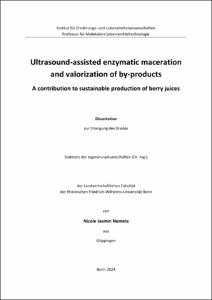Ultrasound-assisted enzymatic maceration and valorization of by-productsA contribution to sustainable production of berry juices

Ultrasound-assisted enzymatic maceration and valorization of by-products
A contribution to sustainable production of berry juices

| dc.contributor.advisor | Schieber, Andreas | |
| dc.contributor.author | Nemetz, Nicole Jasmin | |
| dc.date.accessioned | 2024-03-06T10:23:05Z | |
| dc.date.available | 2024-03-06T10:23:05Z | |
| dc.date.issued | 06.03.2024 | |
| dc.identifier.uri | https://hdl.handle.net/20.500.11811/11395 | |
| dc.description.abstract | Red berry juice, rich in secondary plant metabolites such as anthocyanins, represents a good alternative to the consumption of red berries. According to the German Association of Nutrition, a consumption of five portions of fruits and/or vegetables per day is recommended. However, the average intake of the German citizens only amounts to 50 – 60% of daily fruit and/or vegetable intake. Thus, fruit juice producers are interested in reaching for the potential in berry juice consumption as a part of the daily intake and to increase the content of bioactive compounds in the juices. The extraction of phenolic compounds (PCs), facilitated by the enzymatic maceration, is decisive in juice production resulting in a by-product with low PC content. In juice production, more than 20% of the fruit accrue as pomace. However, the great potential of pomace has not been fully exploited, yet. Currently, pomace is used as animal feed, discarded, or only parts of it are utilized for PCs extraction. Optimization of the juice production by ultrasound (US) or valorization of by-products is of relevance in juice industry to produce sustainably and to preserve heat sensitive PCs. The present thesis aimed to investigate the effects of US treatment during enzymatic maceration (UAEM) conducted at gentle conditions on chokeberry juice production on pilot-plant scale. Further, a strategy for the valorization of pomace was investigated by producing coloring foodstuffs originating from dried berry pomace. UAEM resulted in lower yields of pomace making juice production more resource-efficient and further improved cell wall polysaccharide degradation. Thermal and storage stability of anthocyanins were improved by UAEM. Milling of the seedless fraction of dried berry pomace presents a promising valorization technique. The intact cell structure and a high content of PCs ensured an improved storage stability of anthocyanins in pomace powders. Compared to other coloring foodstuffs, red pomace powders showed acceptable color stability and enables a wide application in food industry. Hence, the present dissertation provides new insights into the promising potential of an advanced conventional chokeberry juice production by applying US at gentle conditions resulting in juices rich in PCs and enabling the valorization of berry pomace on pilot-plant scale with a transfer towards a resource-efficient production. | en |
| dc.description.abstract | Roter Beerensaft, der reich an sekundären Pflanzenstoffen wie Anthocyanen ist, stellt eine gute Alternative zum Verzehr von Beeren dar. Laut der Deutschen Gesellschaft für Ernährung wird ein Verzehr von fünf Portionen Obst und/oder Gemüse pro Tag empfohlen. Jedoch beträgt der durchschnittliche Verzehr der deutschen Bevölkerung dieser Empfehlung lediglich 50 – 60 % der täglichen Obst- und/oder Gemüsezufuhr. Die Fruchtsaftindustrie sieht daher ein hohes Potenzial darin, den Saftkonsum als Teil der täglichen Zufuhr zu nutzen und den Gehalt an bioaktiven Substanzen in den Säften zu erhöhen. Die Extraktion phenolischer Verbindungen (PCs) stellt einen entscheidenden Punkt bei der Saftherstellung dar, welcher durch die enzymatische Mazeration erleichtert wird und den Gehalt an PCs im Trester verringert. Während der Saftherstellung fallen mehr als 20 % der Beeren als Trester an. Das große Potenzial des Tresters ist jedoch noch nicht ausgeschöpft, denn nur Teile werden in der Industrie weiterverwertet und der Rest zu Futtermittel verarbeitet oder entsorgt. Die Optimierung der Saftherstellung mit Hilfe des Einsatzes von Ultraschall (US) oder der Aufwertung des Tresters kann die Saftproduktion umweltfreundlicher und nachhaltiger gestalten sowie hitzelabile PCs erhalten. Das Ziel der vorliegenden Arbeit war, die Auswirkungen der US Behandlung während der enzymatischen Mazeration (UAEM) unter schonenden Bedingungen auf die Aroniasaftproduktion im Technikumsmaßstab zu untersuchen. Weiterhin wurde eine mögliche Strategie zur Aufwertung von Beerentrester in Form eines färbenden Lebensmittels untersucht. Die UAEM führte zu einer verminderten Tresterausbeute sowie zu einem begünstigten Zellwandpolysaccharidabbau. Durch die UAEM wurden die Hitze- und Lagerstabilität von Anthocyanen in Säften verbessert. Als vielversprechende Aufwertungsmethode wird das Vermahlen der kernlosen Fraktionen getrockneter Trester zu feinen Pulvern angesehen. Hohe Gehalte an PCs und die intakte Zellstruktur sorgen für eine hohe Lagerstabilität der Anthocyane. Im Vergleich zu anderen färbenden Lebensmitteln zeigte die Verwendung von rotem Tresterpulver eine akzeptable Farbstabilität, was ein breites Anwendungsspektrum in der Lebensmittelindustrie bietet. Die vorliegende Dissertation liefert neue Erkenntnisse über das vielversprechende Potenzial, die konventionelle Aroniasaftproduktion durch die Anwendung von US unter schonenden Bedingungen voranzutreiben, was zu Säften führt, die reich an PCs sind, sowie der Verwertung von Beerentrester, um den Transfer in Richtung ressourceneffizienter Produktion zu ermöglichen. | en |
| dc.language.iso | eng | |
| dc.rights | In Copyright | |
| dc.rights.uri | http://rightsstatements.org/vocab/InC/1.0/ | |
| dc.subject.ddc | 630 Landwirtschaft, Veterinärmedizin | |
| dc.title | Ultrasound-assisted enzymatic maceration and valorization of by-products | |
| dc.title.alternative | A contribution to sustainable production of berry juices | |
| dc.type | Dissertation oder Habilitation | |
| dc.identifier.doi | https://doi.org/10.48565/bonndoc-245 | |
| dc.publisher.name | Universitäts- und Landesbibliothek Bonn | |
| dc.publisher.location | Bonn | |
| dc.rights.accessRights | openAccess | |
| dc.identifier.urn | https://nbn-resolving.org/urn:nbn:de:hbz:5-75061 | |
| dc.relation.doi | https://doi.org/10.3390/molecules26092689 | |
| dc.relation.doi | https://doi.org/10.1016/j.crfs.2023.100518 | |
| ulbbn.pubtype | Erstveröffentlichung | |
| ulbbnediss.affiliation.name | Rheinische Friedrich-Wilhelms-Universität Bonn | |
| ulbbnediss.affiliation.location | Bonn | |
| ulbbnediss.thesis.level | Dissertation | |
| ulbbnediss.dissID | 7506 | |
| ulbbnediss.date.accepted | 31.10.2023 | |
| ulbbnediss.institute | Landwirtschaftliche Fakultät : Institut für Ernährungs- und Lebensmittelwissenschaften (IEL) | |
| ulbbnediss.fakultaet | Landwirtschaftliche Fakultät | |
| dc.contributor.coReferee | Weisz, Ute |
Dateien zu dieser Ressource
Das Dokument erscheint in:
-
E-Dissertationen (1115)




